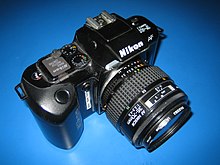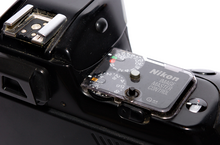Nikon F-401
The Nikon F-401 (in North America as the N4004 called) is a small picture - SLR Nippon Kogaku (since 1988 Nikon ). It appeared in 1987 as the third autofocus single lens reflex camera (after F3 AF and F-501 ).
The F-401 was the first Nikon to use the aperture control capabilities of the AF Nikkor . Only the actual shutter closure is transmitted mechanically. The exposure metering is switched off for lenses of the type AI and AIs. Nikon later adopted this procedure for all SLR cameras in this price range.
The Nikon F-401 is primarily designed for use with automatic programs . Aperture and automatic aperture control are available, but they are hardly useful because the automatically selected parameter is not displayed. Manual exposure adjustment is also possible.
The matrix measurement of the Nikon FA from 1983 was taken up in a greatly simplified form, it only uses two instead of five measuring fields.
For the first time on a Nikon, the entire exposure control, including the aperture, is carried out exclusively from the camera, the aperture ring must remain locked. The time and aperture are set using two small dials on the top of the camera. This construction means that the F-401 is the oldest Nikon, which is fully compatible with the later released lenses without aperture ring (G-Nikkor) in terms of exposure functions.
The autofocus (AF) was limited according to the standard of the time to a central, horizontally arranged line sensor. As with the F-501, the AF motor is built into the camera. In contrast to the F-501, the F-401 cannot control the built-in AF motor of the Nikkor lenses for the F3 AF. Also, with the later released Nikkor with built-in AF motor (AF-I and AF-S) no autofocus function is possible.
For the first time, the function of imprinting the date was not implemented by means of a data back wall available as an accessory, but instead offered a special variant as the F-401 QD.
In 1989 the F-401 was replaced by the almost identical successor model F-401s (N4004S) . First and foremost, a locking option for the time and aperture setting wheels was introduced. Furthermore, the AF sensor has been replaced by an improved version and the AF motor has been strengthened. The version with built-in data back is called F-401s QD or N4004s QD.
The third version was the F-401X (N5005) in 1991 . It is a completely new design, which only ties in with the previous models in the arrangement of the operating elements and the range of functions. The autofocus enables focus tracking for the first time. The exposure measurement was switched to a five-field matrix measurement.
By choosing to add a built-in flash unit to this camera, the problem was that the 'Nikon logo' was no longer visible from the outside. It was therefore decided to put the manufacturer's name in large gray embossing (e.g. F-401s, 1989) on the inside of the battery compartment handle. A compromise when you consider that the lettering is covered by the photographer's hand as soon as he uses the camera. Unique in terms of Nikon's camera design. The design quote on the F3 with the pale red dividing line in various sizes extends to the D-series cameras (DSLRs) to this day. On the F3 model, this dividing line separated the unleathered grip surface from the leather-covered body surface.
Furthermore, on almost all models of this camera, a peeling of the double-sided adhesive tape that holds the small plastic disc that is used to cover the two aperture and time setting wheels can be observed. The spring underneath, which releases the lock in order to set values, constantly pushes this disk up, so that it is missing in many older cameras.

